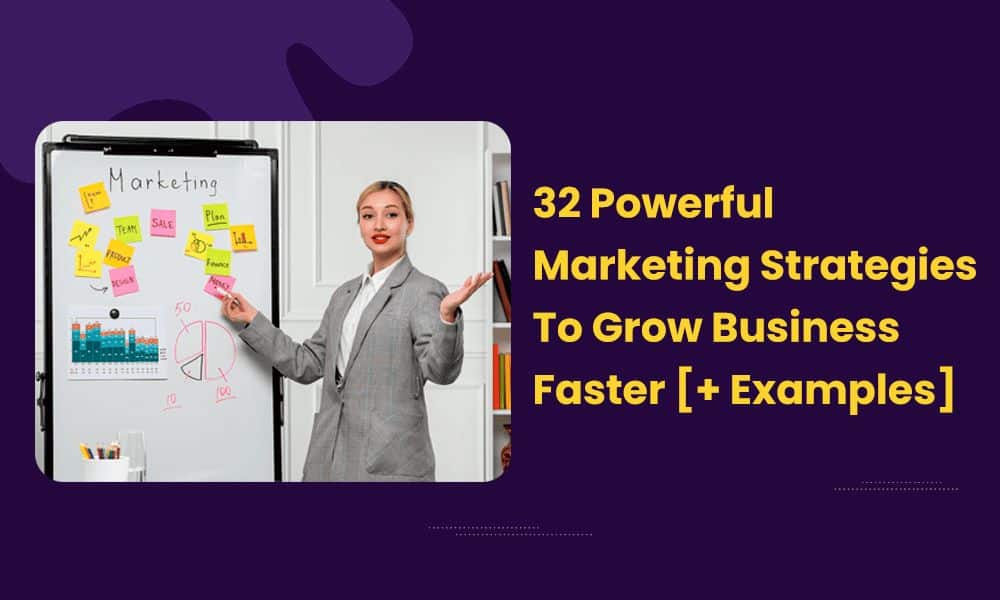The best marketing strategies of all time are always about the basics of human behavior.
After all, if you’re not able to understand the psyche of your potential customers, no amount of ad spend can save your business.
Marketing is the most important part of growing a business—and if you’re looking for a marketing strategy that is truly potent, there are two things you should know:
- What are the best marketing tactics and,
- How these marketing methods work best.
In this blog post, we have explained 32 powerful marketing strategies that can help any business get off the ground and reach its potential customers.
We have also shared easy tips for executing these marketing initiatives and, more importantly, 10 awesome marketing examples that have worked wonders for companies around the world.
Read on.
Table of Contents
What Is a Marketing Strategy?
A marketing strategy is a plan that covers how a company positions its brand image and products or services in the market, how it reaches new customers or clients, how much it spends on marketing each year or quarter, where it focuses more on distribution of organic content and paid ad spend, and other such key decisions that influence the overall marketing of the company.
A good marketing strategy is a mix of inbound and outbound strategies. Inbound marketing involves creating and distributing helpful content that people can find organically. And outbound marketing involves pushing promotional messages to a wide audience in the hope of reaching potential customers.
The marketing strategy of any company is perhaps its most important asset since it impacts how, when, and where customers discover the company and its products or services, and what image the customers form in their mind about the company and its offerings.
The Four P’s of Marketing Strategy
The ‘four Ps of marketing strategy’ are often referred to as the pillars of developing a marketing strategy, as they implement all factors needed to market a product successfully.
The four Ps include key factors such as marketing to the right market, understanding what the customer wants, and also understanding why a product or marketing plan fails to meet these wants, among many other crucial influences.
Here are the four Ps of creating a marketing strategy:
- Product
- Price
- Place
- Promotion
Let us now understand each of these four factors in depth.
Product
The product forms the crux of any company. In order to understand the market and develop a marketing strategy, it is important to answer the most fundamental question—who needs your product, why would they need it, and how would they use it?
By understanding this aspect of a product, you will gain a new perspective on how to target your customer better and how to stand out from your competitors. An important responsibility of a marketing professional is to understand the quality and characteristics of a product and deliver it exactly as it is to the customer.
One key facet of marketing strategy is understanding the lifecycle of a product and having a plan in place to tackle challenges faced at each phase of the product.
Price
The price factor is the set amount a customer is willing to invest in your product or service. Determining the right price amount can be tricky.
A marketer must always consider various factors such as raw material costs, retail markup, competitor prices, etc., and, most importantly, evaluate the product according to its real value.
Although this valuation is largely based on diversified factors, some companies might value their product higher to narrow the target to a higher economic crowd, while some brands might prove the product lower to appeal to a larger crowd.
Place
Place as a marketing strategy is nothing but the ‘marketplace’ where all the magic happens. The decision to know where best to sell your product is key to the marketing strategic plan.
Whether your product is primarily going to be sold online or in brick-and-mortar outlets, it is important to understand which playfield works best for your product.
For instance, if you are a luxury brand focused on major skin care lines, the best way to display your product would be through physical shops where customers can test and try your products.
Also, the ideal outlet would be established luxury outlets such as Sephora. The term place also represents marketing your product through the right channel to garner the attention of the right audience.
The goal of any marketing strategy is to reach the target audience. ‘Place’ helps guide your marketing plan in the right direction and helps achieve this goal.
Read also: Master the Art of Small Business Growth — An 8-Step Journey to Success
Promotion
Lastly, promotion.
Promotion is the final step and an important one when it comes to marketing strategies. Promotion is essentially letting the world know about your product, communicated effectively.
The promotion also helps consumers understand your product and how your product stands apart from your competitors. This component is multifaceted, not just adhering to advertising as one channel. Marketing plans such as public relations, advertising through the right channels, affiliate marketing, and an overall independent media marketing strategy are needed for a robust marketing game.
Promotion and place are important aspects of getting your product out there. Quite obviously, they go hand in hand. Both are needed to be in sync to reach the target audience at the right time.
A good marketing strategy example would be how ‘promotion’ influences or pushes a customer toward a purchase at an online store. This is especially true when it involves promotion on social media and the traffic it drives to the brand’s website or landing pages.
Another great way to promote your products online is by creating interactive flipbooks and sharing them with your customers.
Read also: Get Noticed — 16 Creative Marketing Ideas for Small Businesses
Enhance Your Email Marketing
Want to make your emails more impactful? Check out our beautiful, easy-to-customize marketing email templates. Designed to boost engagement, these templates from EngageBay will help your emails stand out. Just customize the images, headings, and CTAs for your brand, and hit send in a few minutes!
Powerful Marketing Strategies To Grow Your Business Faster
All small businesses want a low-budget marketing plan. The problem, however, is determining which of the successful small business marketing strategies offer the highest ROI.
That’s why we are sharing a list of high-ROI marketing strategies that you can and should steal from the industry today.
1. Set a goal and a budget
Every business needs a direction. Every marketing campaign needs to start with a marketing goal and a budget.
This is perhaps the only free marketing strategy in the world.
Without a marketing goal and a budget, it becomes exceptionally difficult to determine whether or not your campaign was successful.
Plus, according to CoSchedule’s roundup of 2018 digital marketing statistics, marketers who set goals for their campaigns are 429% more likely to report success.
As Forbes contributor Jayson DeMers says, this makes sense because:
“Goal-setting eliminates subjective perceptions of reality, making success objectively measurable. In that context, success isn’t a vague idea; it becomes demonstrable.”
Let’s take a look at a few tips for setting your marketing campaign goal and budget:
- Choose 1-5 KPIs to measure. The most popular KPIs to measure include qualified leads, traffic, and direct revenue.
- Set a realistic budget. The U.S. Small Business Administration recommends that small businesses with less than $5 million should spend 7-8% of total revenue on their marketing campaigns.
- Focus on the process, not the goal. Once your goal is set, create a process for achieving it and use your KPIs to measure and continually improve that process.
2. Build your influence
The most successful marketing campaigns help you achieve the highest ROI. Once you build your influence, you can use many more powerful marketing strategies.
With influencer marketing delivering ROI as high as $5.78 for every $1 spent, it’s quickly become one of the most effective marketing strategies for a small business.
This explains why influencers are finding their way into many social media promotional strategies used by small businesses.

To create a successful influencer marketing campaign, Entrepreneur contributor Murray Newlands recommends the following steps:
- Select your KPIs
- Focus on the social media channels where your target market is most present
- Find a credible influencer
- Plan your publishing schedule
- Consistently improve and measure your outcomes

3. Leveraging employees as thought leaders
Alternatively, you could always create influencers from your own employees. Often referred to as thought leadership, social selling, and employee advocacy are becoming more popular with companies who want to amplify their brand message.
Going beyond simply resharing corporate posts, employee advocacy allows each one of your employees to become brand ambassadors and social sellers, sharing the content that makes the most sense for their individual industries while promoting your company—a good content marketing strategy.
In fact, according to LinkedIn, Salespeople who are using social media to sell are 51% more likely to hit their sales quotas over their less social-savvy peers—and they would know. LinkedIn was responsible for nearly 95% of conversions coming from employee advocacy posts in 2021.
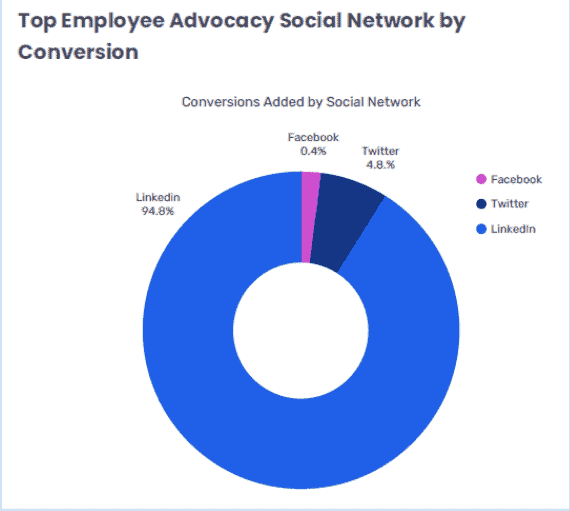
4. Champion one social channel
With the undeniable potential of social media marketing as a small business marketing strategy, it can be tempting to try and find success on as many social platforms as possible.
But, as B2C and B2B marketing strategy guru Neil Patel says, it’s best to focus on one social channel at a time:
“Jumping in head first and attempting to manage, say, four or five different channels can be overwhelming, and you’re unlikely to kill it at any strategy. Even if you’re a savvy marketer, you simply can’t devote the necessary time to extract the full potential of any single channel.”
To become a champion of one social media platform, the team at Social Media Marketo recommends a 12-step process:

5. Build rapport through email
With 59% of marketers claiming that email is their most effective marketing channel for revenue generation, this is one effective inbound marketing strategy that you don’t want to ignore.
If you haven’t started building your email list, Social Triggers founder Derek Halpern recommends a few tips for getting started:
- Create a long-term content strategy to drive organic traffic to your website
- Create multiple opt-in offers
- Utilize an email list popup form
- Add a banner with an invitation to subscribe to your email list
If you want customizable email templates to charm your customers, check out EngageBay’s 1,000+ free HTML email templates. You can also use our email signature generator to create a professional email sign-off with links, banners, and call-to-actions.
Read also: Master Email Marketing Automation Strategy — Tips & Examples
6. Blog strategically
When done correctly, starting a blog is one of the absolute best ways to drive targeted traffic to your website.
In fact, marketers who effectively utilize blogs tend to get 67% more leads than those who do not. But that’s only if you’re doing it right.
To succeed with blogging, you should:
- Find your niche. Choosing a niche is one of the hardest but most important considerations before you start a blog, whether you’re looking to write reviews, sell products online, or general topics.
- Focus on quality over quantity. One long-form, comprehensive post (1,500+ words) is worth 5x a brief, non-informative post.
- Develop a promotion strategy before writing. Many expert content marketers recommend spending 20% of your time on content creation and 80% on promotion.
- Create evergreen content. When you create evergreen content (and update that content when necessary), your content assets compound their impact over time.
- Use photo editing tools like Instasize to curate your content.
- Promote your blog. Create a list of influencers that resonate with your product and start an outreach campaign using powerful outreach tools, requesting them directly or indirectly link back or speak about your blog.
- Design is everything. The way your blog looks can either pull in or push away potential readers, so consider using professionally made templates to create your blog.
7. Conduct research that impacts your SEO
With over 80% of modern-day consumers ignoring ads altogether, ranking for targeted keywords has never been more important.
To rank in SERPs for keywords that can drive high-quality leads, there are a few simple tips that you should follow:
- Focus on low-competition, long-tail keywords. If you own a wedding business, you’re not going to compete with David’s Bridal for the keyword “wedding dress.” Instead, you should focus your efforts on low-competition, long-tail keywords that are relevant to your audience.
- Utilize tools like SE Ranking, SEMRush, or KWFinder. While it may be tempting to use Google’s Keyword Planner, it’s been proven that they hide many low-competition keywords to increase ad spend. A marketing tool like SEMRush and/or KWFinder makes it incredibly easy to find high-ROI keywords that can drive high-quality leads to your website.
8. Teach others
As Forbes contributor Brian Sutter says, “Teach, don’t sell…”
“The idea of teaching instead of selling seems to turn marketing on its head, and yet it’s at the core of content marketing. ‘Teach, don’t sell’ is exactly what makes content marketing different from advertising.”
This is a concept that far too many modern-day marketers misunderstand. And it’s why many businesses struggle to differentiate their message through content marketing.
To ensure you’re teaching your audience the right way, Sutter recommends that you:
- Don’t include CTAs that ask readers to buy something in every piece of content
- Focus on your potential customers and what they want to know, not what you want to tell them
- Be generous with the content you offer
Read also: 14 Creative Social Media Contest and Giveaways Ideas That Work
9. Survey, listen, and learn
Marketing research plays a crucial role in the success of your small business marketing strategies. After all, if you don’t know the audience you’re marketing to, it’s going to be difficult to communicate with them effectively.
One of the best ways to perform market research is through the use of surveys. To get the most out of this successful marketing strategy, Survey Monkey recommends that you:
- Define your marketing objectives for the research
- Set timelines
- Segment your audience to determine who receives which survey
- Use proven tools that allow you to collect and analyze data
10. Re-examine your landing pages
One small business marketing tactic that can immediately impact conversions is the focus of your landing pages.
While most conversion experts are quick to recommend that you should always start your B2B marketing campaign with a dedicated landing page, many fail to mention the importance of focusing on a single goal.
For your landing page to succeed, your focus should be on getting your readers to take a single action. After all, if you have 20 links on your landing page, your attention ratio is 5%. With one link, that ratio is 100%.
This simple act of focusing on getting your readers to take one action on each page can do wonders for your conversion rates.
If you aren’t using landing pages to help sell your products or services, you could be missing out on countless potential customers.
11. Stand for something
A recent McCann study found that 42% of American consumers believe that brands and companies are less truthful today than they were two decades ago.
Translation: Almost half of all consumers don’t trust modern-day businesses.
With this in mind, standing for something that’s important to both you and your target audience can become a huge differentiation factor. Take, for example, the ALS ice bucket challenge that went viral and raised $220 million for the ALS Association.
Here are a few ways you can do it:
- Sponsor a charitable event
- Join forces with your employees and customers for a fundraising event
- Donate your product/service to a charity event
Read also: Creative Event Marketing Ideas to Get People Excited
12. Leverage social media advertising
Social media and mobile marketing have certainly changed the game as far as how modern-day marketing works.
But while many small businesses focus their efforts on the free and low-cost marketing opportunities that social media platforms offer, ads have also proven effective in driving ROI.
Unsurprisingly, Facebook dominates the world of social media advertising, as over 93% of marketers use some form of Facebook ads in their social media marketing strategy.
To get the most out of your Facebook ad campaign, there are a few things you’ll want to focus on:
- Ensure that you’re creating an attractive offer
- Track the right KPIs
- Utilize attractive images and/or videos
- Set clear, measurable goals
Or, consider using an ad tool to get accurate analytics on your social media ads and determine which ones have the best ROI.
13. Leverage Google’s Local Offerings
As a small business, local Search Engine Optimization can make or break your business.
While determining the driving forces behind which local businesses rank highest in Google is still somewhat of a mystery, the below graphic from Moz breaks it down in an easy-to-understand way:
By focusing on optimizing local SEO for the above factors, you can quickly position yourself for success in the SERPs.
14. Prioritize retention
It’s hard to debate the importance of customer retention to the long-term success of your small business.
The probability of selling to an existing customer is approximately 65%, and that of selling to a new customer is about 10-15%. To ensure that more of your customers continue to purchase from you, growth marketer Sujan Patel recommends that you focus on improving your onboarding process.
To do it, Patel says that you should:
- Establish the point where you’re losing customers and focus your efforts there first
- Define your customers’ definition of success and help them achieve it
- Help your customers achieve quick wins
- Create evergreen resources
Read also: 14 Small Business Marketing Truths No One Bluntly Tells You
15. Woo your audience
Storytelling is a powerful tool for any marketer. It can drive up conversion rates by as much as 400%. While it can be difficult to measure, there’s little doubt that storytelling can effectively market your business and attract loyal customers.
To do that, Forbes contributor Mike Kappel recommends these essential tips for business storytelling:
- Determine the parameters (who, what, when, where)
- Be completely authentic
- Determine the outcome
- Be consistent
- Allow customers to become part of the story
Read also: Experiential Marketing Ideas for ‘Next Level’ Brand Campaigns
16. Explore partnerships
Exploring and utilizing partnerships with other small businesses can exponentially boost your business’s revenue potential.
As Entrepreneur contributor Web Smith points out:
“You can survive alone, but you’ll only really thrive when you plug into the community around you.”
To develop effective partnerships, Smith recommends that you:
- Be upfront about your business
- Ask the right questions
- Focus on partnership opportunities that can be mutually beneficial
17. Enable your audience to get to know, like, and trust you
Webinars have become a go-to marketing strategy for tech businesses with a good digital presence.
However, small businesses that are not so tech-savvy are missing out. With webinars being noted as among the top 5 most successful marketing strategies, you need to take advantage of this trend.
Amy Porterfield uses webinars as a critical component in building her customer base. She says webinars help her audience get to know, like, and trust her.
To borrow from Forbes Contributor Ashley Stahl, a webinar host should:
- Focus on creating amazing content
- Choose a time that’s convenient for your target audience
- Prepare, prepare, prepare
18. Promote a free consultation
While it will undoubtedly vary by industry, the conversion rate of offering free consultations makes it one of the most effective small business marketing strategies trending today.
In fact, in some cases, even medical businesses have seen conversion rates as high as 75% when they offer free consultations. Let’s take a look at a few tips to raise the likelihood of turning a lead into a customer through your free consultation:
- Focus on helping the customer and creating a quick win for them
- Ask targeted questions
- Show them why and how you can help them
A free demo goes a long way in clarifying the customer’s doubts and building trust.
19. Omnichannel marketing
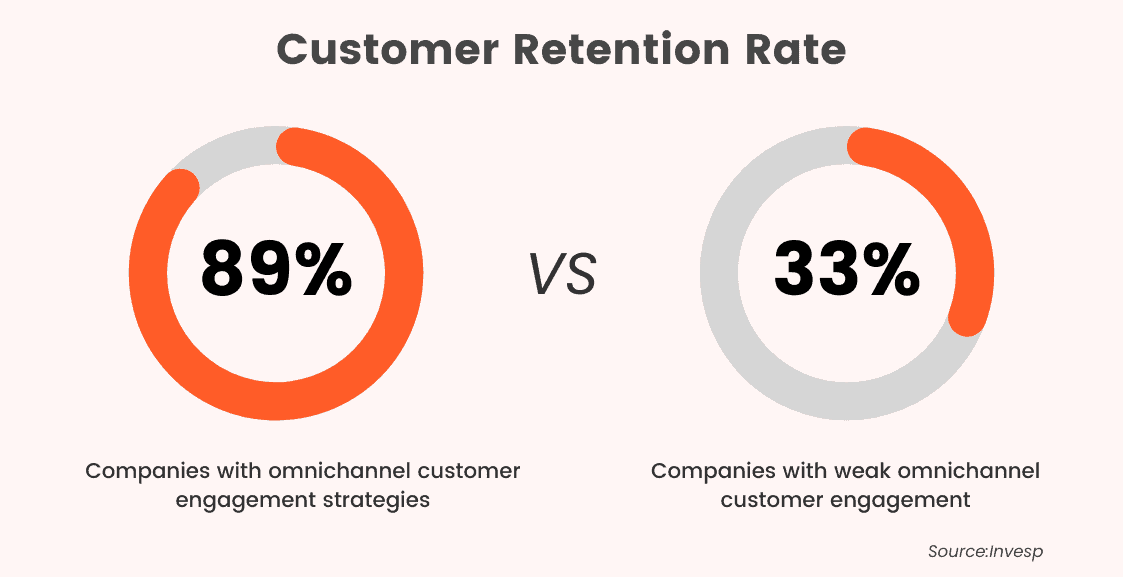
Omnichannel is a customer-centric approach in which all channels are seamlessly integrated to provide a consistent brand experience, whether customers are at a physical store, using an app, or on a website.
Let’s understand this with the help of an example. Suppose you are browsing Facebook on your phone and spot a new gadget that you find appealing. You clicked on the company’s website to get more information about that product. However, you did not go ahead with buying that product.
The very next day, you see the same gadget on Instagram and get an email or a text message with special offers. This is the magic of omnichannel marketing, which integrates all platforms to provide a unified experience to your customers.
Now, you can imagine how omni-channel marketing can turbocharge your business growth. Some major reasons you should implement this element in your marketing strategy today are:
- Increases customer engagement
- Better customer retention
- Improves customer journey
- High return on investment
- An integrated approach
- Maximizes performance on each platform
- 360-degree customer view
- Consistent brand experience
20. AI and Machine Learning advantage
Why not leverage AI and machine learning to drive value to your business? Tools supporting AI and machine learning algorithms transform some crucial areas of marketing, such as:
- Personalization
- Product recommendations
- Pricing optimization
- Visual search capabilities
- Predictive analytics
- Automate routine tasks
- Chatbots for 24×7 support
AI and machine learning have the potential to elevate how your business operates and competes in the digital world. Furthermore, with these technologies, you can communicate with the right people at the right time, track user behavior, and tailor customer experiences according to your audience’s preferences.
Adopting AI and ML into your business operations can also help you process and analyze massive amounts of data in seconds to streamline your decision-making process.
Read more: 6 Ways Ai is Changing Self Customer Service for Good
21. Influencer and micro-influencer marketing
It is proven for many successful entrepreneurs and marketers that collaborating with influencers and micro-influencers today creates online buzz about their brand. This not only strengthens their brand awareness but also improves audience engagement, conversions, and retention.
Influencer marketing helps you reach a direct line to your target audience’s hearts and minds. One significant benefit of this marketing strategy for your business is that it connects with your niche audience, which aligns perfectly with your brand.
Moreover, you can have more meaningful interactions with your audience that get you more bang for your buck.
Now, the next question is: Should you opt for macro-influencers or micro-influencers for your business? If you run a small business, choosing micro-influencers makes more sense for two reasons.
The first is that micro-influencers have a more targeted audience and cover more specific topics. Thus, most of their followers will be interested in your brand. However, this is not the case with macro-influencers, as they cover more broad topics.
The second is that macro-influencers may not get you the desired result besides charging a higher sum than micro-influencers.
On the other hand, if you run a medium or large business, you should opt for macro-influencers to maximize your reach, as they have a broad audience.
22. Short-form video content
Short-form video content is quicker to create and can cover an extensive range of topics faster.
A significant reason these videos’ popularity skyrocketed is that they require less time from the viewer. This indicates the audience’s attention spans are shorter, which is why more brands compete for them.
Many small businesses and startups use short-form videos to increase brand awareness, boost sales, and drive website traffic. Thus, creating short videos enables your viewers to become more engaged and gain interest, leading to higher retention rates.
Here are a few aspects that make short-form videos a game-changer for every growing business:
- These videos are highly shareable, increasing the chances of going viral
- Creating these videos is friendly and won’t break your bank
- While attention spans are shrinking, these snackable content pieces deliver your message quickly and efficiently
- In a short time, these videos are highly capable of showing your brand’s unique perspectives
Some of the best platforms you can use to elevate your brand loyalty and increase your customer base with short videos are YouTube Shorts, Instagram Reels, Facebook Reels, and LinkedIn Stories. These platforms help you create engaging, quick content that resonates with modern consumers.
Read more: 12 Top Free and Paid Social Media Video Creator Apps
23. User-generated content (UGC)

User-generated content (UGC), also known as consumer-generated content, is brand-specific content, be it text, image, video, or audio, created by customers rather than the brand itself. The brand does not pay for this original, user-generated content; it automatically comes from its customers when they exceptionally like its products or services.
Lately, many brands have grown this way. The best part when your customers post about your brand on social media or any other channel is that it directly influences their followers’ buying decisions.
Another benefit of UGC for businesses is that they gain valuable insights into their customers’ behavior, preferences, and opinions. As a business owner, analyzing user-generated content can help you gain a deeper understanding of your brand’s target audiences.
UGC also helps your brand build and grow an engaged community by opening a conversation between a brand and its audiences. This strengthens brand loyalty and accelerates growth.
This content is mainly published on social media channels and community forums. You will also see user-generated content in the form of customer reviews and user testimonials.
Some common faces of user-generated content are as follows:
- The unfiltered voice of your customers, which are your customer reviews
- Personal stories that bring your product to life, which are your user testimonials
- Customer posts their personal experience in their Instagram post or reel
- Community forums, where passionate users gather to discuss your brand’s positives and negatives
- Brand hashtag campaigns to turn your customers into brand ambassadors
You can encourage your customers to create and share content related to your brand, which boosts authenticity and trust. But how? Let’s get to know below:
- Ask for feedback from users
- Create a unique hashtag that sets your brand apart
- Launch a getaway or a contest on social media
- Gain some ground with influencers
- Create an employee engagement program
- Create an ambassador program
- Offer your customer an incentive
24. Sustainability and social responsibility
Do you want to take your business to new heights with increased sales, higher employee productivity, and reduced operational costs? Then, sustainable practices and social contributions play a crucial role in marketing. They not only help build trust but also attract conscious consumers.
Social responsibility encourages companies to indulge in more sustainable practices like using recycled products and consuming less energy.
This is why sustainability and social responsibilities have emerged as powerful drivers of business growth across diverse sectors and reshaped how companies operate, innovate, and connect with their customers.
While the benefits are clear, implementing both these practices comes with challenges. However, you can overcome them by:
- Setting clear, measurable goals
- Engaging employees at all levels
- Leveraging technology for efficient implementation and tracking
- Collaborating with industry partners and Non-Government Organizations (NGOs)
25. Personalized PPC campaigns
PPC (pay-per-click) campaigns are a digital marketing model in which advertisers pay each time a user clicks on their ads. They are one of the most effective forms of online marketing, helping businesses target specific demographics, interests, and behaviors of their prospects.
To increase the efficiency of PPC campaigns, most businesses ensure they get immediate visibility on search engines and other platforms. This is where personalizing them and aligning with your brand’s voice and target audience preferences comes into play.
Personalized PPC campaigns ensure your ads reach the most relevant potential customers. By creating tailored ads based on your consumer behavior and interests, you can achieve higher engagement and increase sales.
This targeted approach contributes to higher clicks from people who are more likely to be interested in the advertised product or service and encourages them to buy it.
Some of the ways to make an effective personalized PPC campaign strategy include:
- Define your PPC goals, such as raising brand awareness, increasing web traffic, generating leads, or driving sales, and build a strategy accordingly
- Perform keyword research to meet the needs of someone searching for that keyword
- Analyze your competitors by identifying what keywords they are targeting and what message they are using
- Create clear and concise ads that immediately establish the value you offer
Note: Google text ads have limited space. So make sure you edit the display URL, headline, and description to grab the attention of your target customers and convey something compelling that will help you stand out. The next step involves you to participate in the ad auction. Now, start bidding based on your PPC goals- clicks, conversions, or impression share.
- Specify the location and languages you want to target and select the audience segments
Pro tip: After you launch your PPC campaign, make sure you monitor and modify it regularly to capitalize on ads that bring the most results and modify the ones that need improvement.
26. Cookieless marketing
Cookieless marketing is an alternative strategy for targeting users without relying on cookies or other tracking methods. This marketing strategy focuses on first-party data and does not rely on third-party data.
The primary objective of this marketing strategy is to deliver relevant, personalized ads while adhering to data privacy regulations and respecting user’s privacy.
Cookieless advertising serves as the backbone of how advertisers track users across websites and rely on the same level of detailed targeting and personalized ads.
Here are some compelling ways to prepare yourself for the cookieless world:
- Audit current data practices to evaluate how your business uses cookies currently
- Embrace first-party data from customer interactions, which is permission-based and more effective than third-party counterparts
- Utilize a Customer Data Platform (CDP) to consolidate data from different sources into a unified profile of customers
- Build data partnerships and leverage clean rooms for sharing data safely
- Explore universal IDs to create a constant, alternative identifier for consumers across the web
- Enhance zero-party data strategies to enrich your knowledge about your target audience and complement your first-party data
27. Email marketing
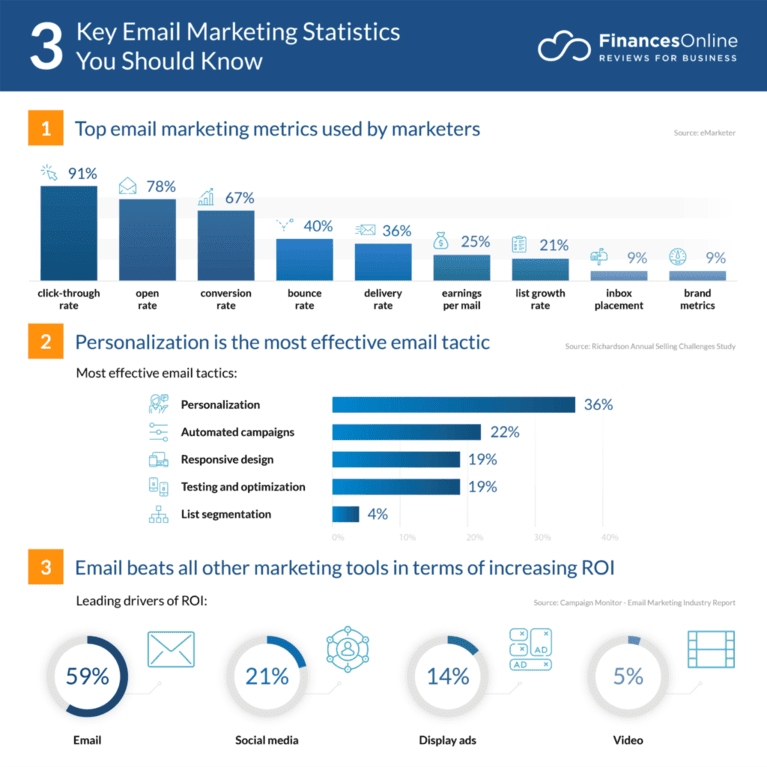
Creating a robust email marketing strategy allows you to reach and connect with your target audiences in a personalized manner.
Email marketing also helps businesses generate a steady stream of qualified leads, drive traffic to their website, boost brand awareness, skyrocket their growth, and increase customer retention.
Personalized, segmented email campaigns are critical for boosting engagement and one of the potent ways to increase sales at an affordable cost.
Developing an effective email marketing strategy requires you to:
- Set clear goals you want to achieve with the email marketing campaign
- Identify the latest trends in your industry and keep up with new features in email marketing, such as 3D design, vibrant colors, animated GIFs, interactive emails, and more
- Spy on your competitors to see how they approach email marketing by analyzing their content, frequency, and engagement tactics
- Audit your target audience and tailor your emails to match their needs
- Focus on organic email list-building
- Segment your email list to send personalized emails
- Categorize the type of emails you want to send- whether they are promotional, behavioral, informational or transactional
- Create customized email templates with email marketing software and infuse high-quality and professional images into your campaign
- Determine sending frequency and the time to maximize its impact
- Run deliverability check to reduce the bounce rate and remove inactive subscribers
Also, make sure you measure your campaign’s results using critical metrics such as open rate, click-through rate, unsubscribe rate, engagement rate, etc.
If you are confused about which email marketing software to choose, we have got your back. EngageBay is one of the most compelling options in the market. This all-in-one tool helps you build accessible email campaigns and ensures that your template is mobile-friendly.
Using this software, you can ensure your email campaign has all these components:
- Header
- Text block
- Images/videos
- CTA
- Footer
28. Content marketing and SEO
Content marketing strategy optimizes your content and website’s technical structure to improve its visibility and ranking in the SERPs. This tells how content marketing and SEO are directly related. But what does content marketing involve?
Content marketing is primarily about creating and distributing relevant content for a targeted audience online. It may include blogs, social media posts, videos, or podcasts to attract, engage, and retain the audience.
The approach of producing authoritative and valuable content helps businesses establish themselves as a thought leader and expert in their niche. This not only builds trust with their audience but also encourages them to engage more with the brand.
Remember, an effective content marketing strategy helps businesses spread their sought-after organic keywords through their websites. This strategy also increases the number of backlinks to enhance off-page SEO.
To amplify your content marketing and SEO efforts, you must integrate these elements into your strategy:
- Create pillar content around broader topics to support your overall website’s content structure
- Build a network of related content around each pillar to increase your website’s authority and ranking on search engines
- Use clear headings, bullet points, and concise definitions to optimize your content for appearing in Google’s featured snippets
- Leverage video content in your blog posts or social media posts
- Optimize for local search with Google My Business and location-specific keywords
Content marketing and SEO are like the peanut butter and jelly of the digital world – great on their own but absolutely irresistible when combined. Once you are able to harness the power of content marketing and SEO, you can fuel success by ensuring your content is discoverable and visible.
Read more: Content Marketing Funnels: The Key to Unlocking Your Brand’s Potential
29. Predictive lead scoring
Predictive lead scoring uses machine learning to predict which leads are most likely to convert based on historical data. This approach facilitates businesses in developing more focused marketing efforts and achieving higher lead qualification rates.
Moreover, creating this sales and marketing alignment streamlines the lead-generation process and empowers teams to meet their objectives.
The best part of implementing a lead scoring strategy is that it reduces the time it takes to qualify a lead.
To execute this predictive lead generation strategy in your business, you must collect detailed information about your leads from different sources. Once you have done this, use data mining techniques to add information from third-party data sources such as social media posts and web forums and compare it with the leads you already have.
Now, you must use predictive analytics algorithms that analyze past data to identify patterns associated with successful conversions.
30. Guerilla marketing
Guerilla marketing is a tactic in which a company generates interest and gets people talking about their brand. The philosophy behind this marketing method is to provide an intimate connection with the target audience to increase brand awareness and visibility in search engines.
But how does this marketing method work? It drives your business growth through direct impact and helps you create high-impact campaigns with minimal resources.
Let’s understand it with an example. Suppose you are walking down a busy street, and you see a giant Gorilla wearing your competitor’s shirt. Wouldn’t it catch your attention? Definitely, it will! That’s guerilla marketing in action.
Thus, it is not wrong to say that it is a cost-effective marketing tactic for creating buzz and attracting attention in a crowded market.
Here are a few exceptional guerilla marketing ideas that will turn heads and spark conversations:
- Ignite social media buzz with shareable moments on LinkedIn, Instagram, Twitter, and Facebook. You can do this by hosting a contest or starting a cryptic thread that unfolds over days
- Tap into your audience’s emotions, whether it’s laughter, awe, or even a shock. You can do this by starting a social media challenge to encourage people to complete and share it with their followers
- Build a strong customer referral program by considering two-sided rewards and communicating the value clearly
- Provide users with personalized year-end summaries of how they use your products or services with eye-catching graphics
All these aspects help increase brand visibility and user engagement.
31. Voice search and semantic SEO
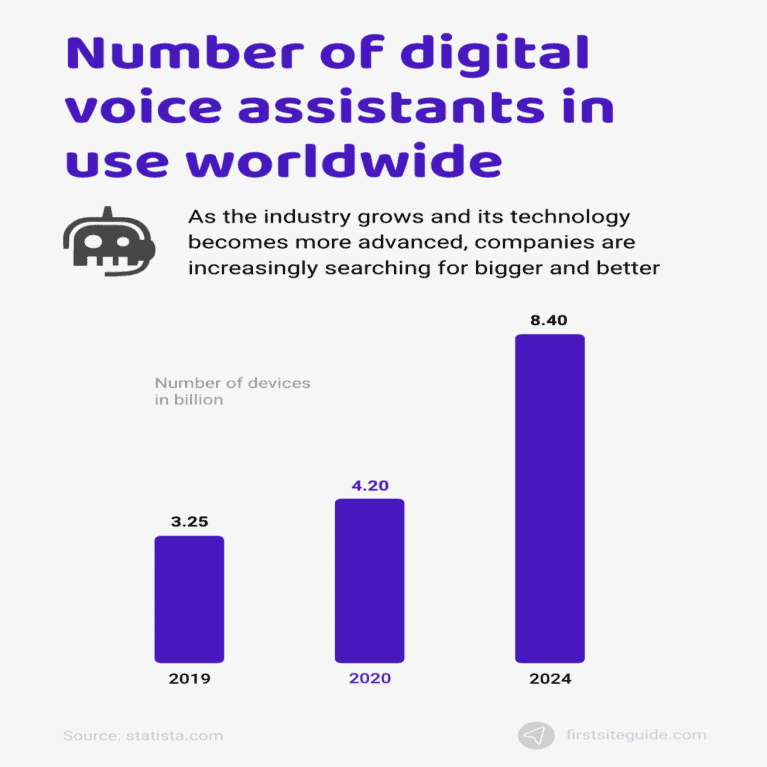
Voice search is a technology that allows you to use a voice command to perform a search on the internet. This feature first appeared on smartphones to reduce the dependency on search bars and make it convenient for users to search for anything with their voice.
Simultaneously, semantic SEO is a strategy that focuses on optimizing your content based on its meaning and context rather than just keywords. This strategy considers the search intent and allows users to get the exact information they want to find.
Combining the power of voice search and semantic SEO increases the visibility of your content in the search results and enhances your user experience.
Moreover, creating semantically rich content by optimizing it for voice queries, helps you gear up to excel in both traditional and voice search results.
32. Data-driven marketing
How about using customer data to devise marketing strategies and brand communications to maximize your ROI? Implementing this marketing strategy helps you gain insights into your customers’ preferences, motivations, and behaviors.
You can improve decision-making and campaign effectiveness by harnessing data analytics acquired through customer interactions.
Furthermore, these insights enable you to personalize and enhance the customer experience for the highest possible return on investment.
You can invest in CRM systems like EngageBay to process and analyze your customer data. This marketing analytics and workflow automation tool facilitates processes such as lead generation, lead scoring, and personalized email campaigns.
With EngageBay, you can also collect and analyze your data and extract actionable insights by:
- Segmenting your audience based on behavior or demographics
- Identifying trends in customer purchasing patterns
- Understanding which marketing channels are most effective
- Personalizing email content based on past purchase history
33. Partnership marketing
Partnership marketing involves collaborating with other brands or individuals to reach new audiences, build business relationships, and boost revenue. These partnerships are a creative, transparent, and relational way to expand the customer base and reach new communities.
While partnership marketing taps into a new customer base by collaborating with other businesses or brands, it also reduces marketing costs by leveraging another company’s reach and reputation.
One of the most attractive parts of this marketing strategy is that it boosts your customer base and revenue without solely relying on your marketing efforts.
Identify potential partners that complement your offerings and share your target audience before you create a partnership marketing plan. Then, create a win-win proposition by ensuring the partnership benefits both parties equally.
34. Bonus strategy: write a column
Writing a column for well-known publications that share your target audience is a great way to drive traffic to your website and generate brand recognition/brand awareness.
Josh Steimle, for example, writes for publications like Forbes, which has provided great leads for his business.
This tactic, which is also known as guest posting, can also help you develop partnerships with businesses and website owners that share your target market.
To succeed with this strategy, Copyblogger recommends that you:
- Focus on the needs of the editor and column you intend to write for
- Create amazing content
- Become a go-to resource
- Don’t be overly promotional—focus on providing value instead
Marketing Done Right: 10 Amazing Examples of Marketing Strategies
Now that we have seen the four pillars of marketing, we have curated marketing strategy examples with different perspectives to have a deeper understanding of how to develop a marketing strategy.
Keeping it real: examples of marketing strategies from big brands
Let’s hear it from the big brands, shall we?
1. Spotify: customizing user experience
Today, the well-known music app Spotify is synonymous with music listening. But, how did this Swedish brand become a huge hit globally among so many streaming music services?
The answer is user experience. Spotify opened a new avenue to listeners by providing a tool to customize their experience with playlists, filtering by genre, and choosing music based on their mood.
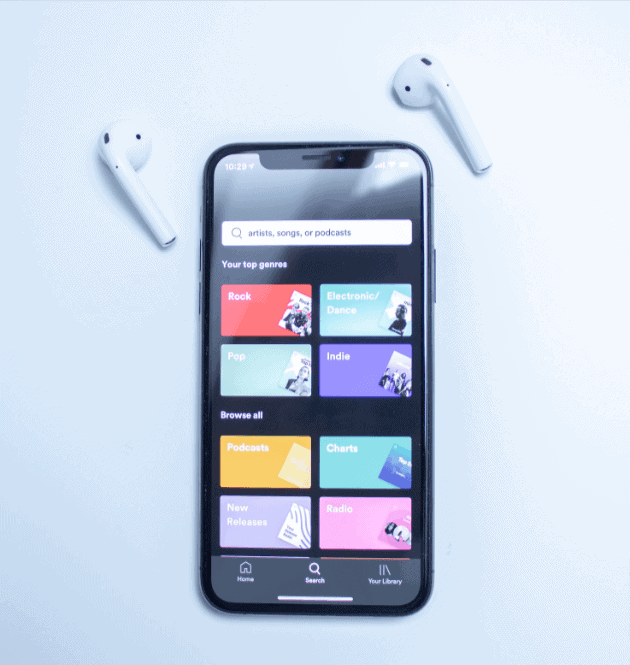
Sports also uses AI to understand the user’s listening habits and curate a specific playlist based on these habits to their taste.
This unique approach to an elevated user experience is an effective marketing strategy that has made Spotify a global leader in the music streaming industry.
2. Nike: By you for you
What better way to market your product than your customers themselves?
That is exactly what Nike did with the ‘Nike By You’ social media marketing campaign. In this innovative approach to developing a marketing strategy, Nike increased 22 % of their revenue through this campaign alone.
In Nike By You (2015), customers were the designers for the new Nike dunk low. But this approach has been extended today to all their products today.
By allowing a customer to have a unique experience of customizing their own shoes, Nike has provided a fine example of the marketing strategy by making the customer the driver of the campaign.

Nike has used technology to its fullest advantage and focussed on customer-oriented themes to drive the brand’s marketing strategies.
Smart!
3. GoPro: user-generated marketing campaign
GoPro is a staple name when it comes to mountaineers, athletes, adrenaline junkies, and pretty much anyone who’s on an adventure-seeker. This is due to the unique product, the GoPro camera itself, and the quality of the content it produces.
The best testimony of a product is the user-generated content for the product itself. Now GoPro cameras are popular in recent times due to the number of ordinary people, without filmmaking backgrounds, using them to create stunning content, with great cinematography.
GoPro sought to implement this particular marketing strategy to promote its product on social media.
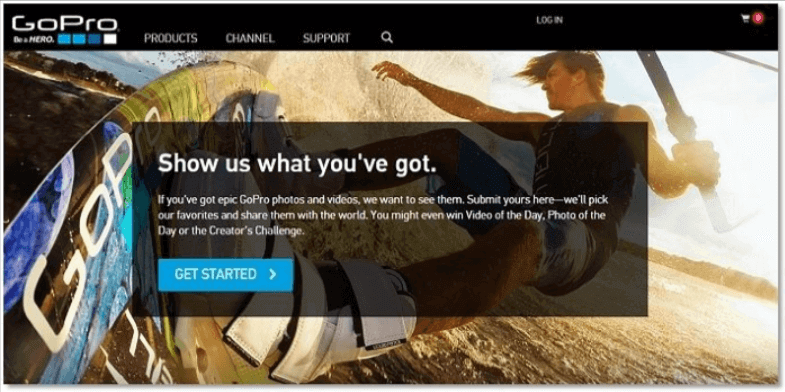
With the videos submitted by users themselves, the videos are shared on social media, which inspires more people to shoot stunning videos and post their own content.
Hence this positive cycle has increased sales and recognition for GoPro and its stunning products. User-generated content for the win!
4. McDonald’s: the ‘Glocal’ campaign
McDonald’s is everyone’s favorite fast food chain.
We all love it!
But how does McD ensure we all stay lovin’ it? McDonald’s social media marketing strategy has been well-received globally due to its adaptability to local cuisines.
As part of their ‘Glocal’ campaign, they have introduced local dishes as part of their extended menus in international outlets. For example, in the middle east region, McArabia has a specialty ‘McShawarma’ dish, which has been quite a success in local marketing.

This type of localized marketing strategy has helped McDonald’s appeal to a local audience while growing globally as the world’s favorite fast-food chain.
5. Sephora: winning with loyalty
Sephora, a well-known cosmetic giant, used the most powerful marketing strategy to its advantage, customer loyalty. With a well-planned marketing strategic plan, they introduced a loyalty program with different classes of divisions based on points.
Known as the ‘beauty insider’, based on the annual spending of a customer, they are divided into three primary categories. The highest bracket is extremely lucrative to customers with high-quality incentives and discounts.
This concept of encouraging customers to spend more on their brand in order to get enticing rewards in return has made Sephora successful today.

Small to success: small business marketing examples that made it big
We know big brands have the resources to pull off some of the best marketing strategies. That said, what about small businesses?
1. $1 to $1 million success story: The Grilled Cheese Truck
The grilled cheese truck is a simple small business idea of a food truck serving grilled cheese sandwiches. The company was initially started in Los Angeles in 2009 and soon expanded across additional markets all over the country.
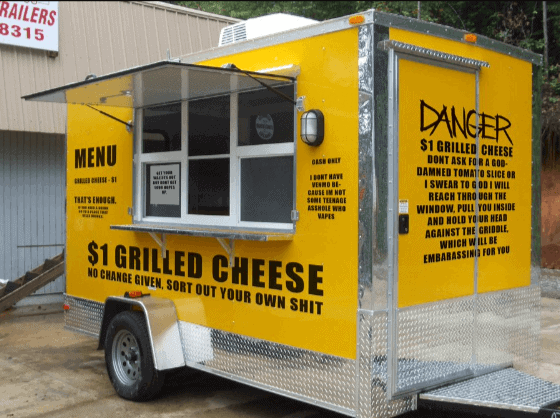
This B2C food truck became an overnight success with a rapid expansion to three additional markets across two states due to its extensive social media marketing efforts.
By this quarter of 2014, the company was churning out almost $1 million in sales.
Key notes: the marketing strategy implemented
- Extensive Social media marketing with a steady loyal following to increase visibility.
- Using Social Media to announce locations, discounts, and events.
- Strategic partnerships with local businesses to increase brand awareness across different regions
2. Impactful influencer marketing: My Makeup Brush Set
My Makeup Brush Set, initially a small branch of AN commerce, offers professional makeup brushes at an affordable price range. Founded in 2014, this brand and concept has steadily grown but failed to reach the most important audience, pool-millennial women.

To target this particular audience profile, they specifically tailored their social media campaigns to teenage girls. Unique, appealing content, creative video marketing efforts, and a direct response campaign were introduced to increase their visibility.
They also, very smartly, partnered with key influencers to drive their marketing campaigns even further. The result – their sales increased manifold and they were able to expand their business to further states and globally.
Key notes: the marketing strategy implemented
- Tying with key influencers and staying on trend made the theme known to a wider global audience, both offline and online.
- With creative videos and targeted ads, specific to a set target profile (women aged 18-35), they were able to increase their revenue and sales exponentially.
- With the help of ‘email marketing’, the brand was constantly in touch with customers and was able to market offers and exclusive promotions to further strengthen its marketing stronghold.
3. The cat’s out of the bag: content marketing and Saddleback Leather
Saddleback Leather- a premium leather bag company, was already a household name a few years after its inception.
However, with the advent of the internet, the brand released a strong social media presence that was needed to expand and keep the revenue flowing. With beautiful products to display and promote, a graphical representation wasn’t simply enough.

To tie in with its secure social media presence, the brand started a substantial and steady’ content marketing campaign. Now, content marketing does not mean constant updating and long blog posts.
Quality, engaging content is needed to be a hit with customers. Saddleback Leather knew this trick and has done a great job pioneering content marketing to engage with potential customers.
Not only is the content great and attractive, but it also showcases the beauty of its products brilliantly.
Key notes: the marketing strategy implemented
- Strategic content marketing plan that showcases their products with high-quality and engaging content.
- Providing lifetime guarantee for their quality products to build a steady but strong and loyal customer base.
- Using eCommerce to further strengthen their sales and marketing drive.
4. Simple idea, unique execution: John’s Crazy Socks
Who would’ve thought that the simple idea of selling socks could one day make it to Forbes?
John Cronin did!
Started in 2016, John’s Crazy Socks was initially started to raise funds for Down’s syndrome awareness.
But what made this brand a success is how the social media marketing was focused on building a community who could relate to the back story and were inspired to buy the products. Their tagline ‘Socks that make a difference’ resonated with thousands across the country and eventually around the globe.

To capitalize on this ripple effect, they steadily introduced new creative promotions to encourage new buyers to make the purchase.
Key Notes: the marketing strategy implemented
- What made John’s Crazy Socks a crazy night success story is the social media influence and constant engagement with the community of like-minded people itself.
- Paired with social media marketing strategy was the creative promotion such as the ‘sock of the month’ which made the brand even more popular
- A personalized thank you note for each customer addresses a humane touch and strengthens the bond between the customer and the brand, making it unforgettable.
5. Smartly Tattly: Tattly’s smart marketing strategy
Businesses today, small and big, are constantly facing challenges with competition, market saturation and so many choices for consumers in this digital era. Standing out from the competition is quite challenging and requires a colossal amount of effort.
Tattly, a unique temporary tattoo company, came up with different strategies to make a mark and stand out. Temporary tattoos are often focused on children. But Tattly sought to change the narrative by introducing aesthetic, and beautifully illustrated temporary tattoos for adults as well.
By branching out in this manner, they were able to expand their brand profile to a much wider audience. Apart from this proposition, they also had a strong content marketing campaign to do the heavy lifting for the beans in terms of furthering their brand awareness.
The role of temporary tattoos for adults is still a niche and Tattly capitalized on this aspect and focussed their marketing efforts on this.
Key notes: the marketing strategy implemented
- Expanding brand awareness and knowledge on temporary tattoos through extensive content marketing
- Using social media campaigns to market to the right audiences, thus furthering the reach globally
- Strategic partnerships with artists globally to create unique tattoo designs and market them in the right way.
 Conclusion
Conclusion
In this blog post, we have shared with you 18 (actually, 19) of the best marketing strategies of all time. We sincerely hope that you have enjoyed reading and learning from them.
Do you know any other digital marketing strategy not listed here that has proven to work for businesses? If YES, do let us know about it in the comments section below.
Also, please share this post with your colleagues and friends who might find these online marketing strategies helpful too. If you need a free marketing software, remember that EngageBay is designed for novice marketers and small businesses.
This all-in-one email marketing, landing page builder, and customer support software is free to use for a small number of contacts, and super affordable when you scale.
FAQ
1. What’s a marketing strategy?
Think of it as your business’s game plan for reaching potential customers. It’s all about figuring out who to target, what you want to achieve, and how you’ll reach them across different channels.
2. How do you create a marketing strategy?
Start by researching your market and competitors. Then, set clear goals and track your progress. Choose the marketing methods that resonate with your target audience and fit your budget. Finally, put a timeline together and get moving!
3. Marketing strategy vs plan: what’s the difference?
The strategy is the big picture – your “why” and “what” you want to achieve. The plan dives into the specifics – the “how” you’ll get there, step-by-step.
4. What is a marketing strategist?
They’re the masterminds behind the marketing plan! They research the market, identify who to target, and choose the best tactics to reach your goals. They also keep an eye on how things are going and adjust the plan as needed.
